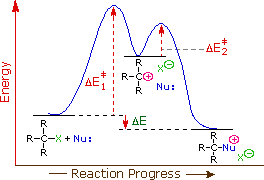


 علم الكيمياء
علم الكيمياء 
 الكيمياء التحليلية
الكيمياء التحليلية 
 الكيمياء الحياتية
الكيمياء الحياتية 
 الكيمياء العضوية
الكيمياء العضوية 
 الكيمياء الفيزيائية
الكيمياء الفيزيائية
 الكيمياء اللاعضوية
الكيمياء اللاعضوية 
 مواضيع اخرى في الكيمياء
مواضيع اخرى في الكيمياء
 الكيمياء الصناعية
الكيمياء الصناعية |
Read More
Date: 29-7-2018
Date: 22-10-2020
Date: 14-12-2020
|
Reaction 7, shown at the end of the previous section, is clearly different from the other cases we have examined. It not only shows first order kinetics, but the chiral 3º-alkyl bromide reactant undergoes substitution by the modest nucleophile water with extensive racemization. In all of these features this reaction fails to meet the characteristics of the SN2 mechanism. A similar example is found in the hydrolysis of tert-butyl chloride, shown below. Note that the initial substitution product in this reaction is actually a hydronium ion, which rapidly transfers a proton to the chloride anion. This second acid-base proton transfer is often omitted in writing the overall equation, as in the case of reaction 7 above.
(CH3)3C-Cl + H2O ——> (CH3)3C-OH2(+) + Cl(–) ——> (CH3)3C-OH + HCl
Although the hydrolysis of tert-butyl chloride, as shown above, might be interpreted as an SN2 reaction in which the high and constant concentration of solvent water does not show up in the rate equation, there is good evidence this is not the case. First, the equivalent hydrolysis of ethyl bromide is over a thousand times slower, whereas authentic SN2 reactions clearly show a large rate increase for 1º-alkyl halides. Second, a modest increase of hydroxide anion concentration has no effect on the rate of hydrolysis of tert-butyl chloride, despite the much greater nucleophilicity of hydroxide anion compared with water.
The first order kinetics of these reactions suggests a two-step mechanism in which the rate-determining step consists of the ionization of the alkyl halide, as shown in the diagram on the right. In this mechanism, a carbocation is formed as a high-energy intermediate, and this species bonds immediately to nearby nucleophiles. If the nucleophile is a neutral molecule, the initial product is an "onium" cation, as drawn above for t-butyl chloride, and presumed in the energy diagram. In evaluating this mechanism, we may infer several outcomes from its function.

First, the only reactant that is undergoing change in the first (rate-determining) step is the alkyl halide, so we expect such reactions would be unimolecular and follow a first-order rate equation. Hence the name SN1 is applied to this mechanism.
Second, since nucleophiles only participate in the fast second step, their relative molar concentrations rather than their nucleophilicities should be the primary product-determining factor. If a nucleophilic solvent such as water is used, its high concentration will assure that alcohols are the major product. Recombination of the halide anion with the carbocation intermediate simply reforms the starting compound. Note that SN1 reactions in which the nucleophile is also the solvent are commonly called solvolysis reactions. The hydrolysis of t-butyl chloride is an example.
Third, the Hammond postulate suggests that the activation energy of the rate-determining first step will be inversely proportional to the stability of the carbocation intermediate. The stability of carbocations was discussed earlier, and a qualitative relationship is given below.
|
Consequently, we expect that 3º-alkyl halides will be more reactive than their 2º and 1º-counterparts in reactions that follow an SN1 mechanism. This is opposite to the reactivity order observed for the SN2 mechanism. Allylic and benzylic halides are exceptionally reactive by either mechanism.
Fourth, in order to facilitate the charge separation of an ionization reaction, as required by the first step, a good ionizing solvent will be needed. Two solvent characteristics will be particularly important in this respect. The first is the ability of solvent molecules to orient themselves between ions so as to attenuate the electrostatic force one ion exerts on the other. This characteristic is related to the dielectric constant, ε, of the solvent. Solvents having high dielectric constants, such as water (ε=81), formic acid (ε=58), dimethyl sulfoxide (ε=45) & acetonitrile (ε=39) are generally considered better ionizing solvents than are some common organic solvents such as ethanol (ε=25), acetone (ε=21), methylene chloride (ε=9) & ether (ε=4). The second factor is solvation, which refers to the solvent's ability to stabilize ions by encasing them in a sheath of weakly bonded solvent molecules. Anions are solvated by hydrogen-bonding solvents, as noted earlier. Cations are often best solvated by nucleophilic sites on a solvent molecule (e.g. oxygen & nitrogen atoms), but in the case of carbocations these nucleophiles may form strong covalent bonds to carbon, thus converting the intermediate to a substitution product. This is what happens in the hydrolysis reactions described above.
Fifth, the stereospecificity of these reactions may vary. The positively-charged carbon atom of a carbocation has a trigonal (flat) configuration (it prefers to be sp2 hybridized), and can bond to a nucleophile equally well from either face. If the intermediate from a chiral alkyl halide survives long enough to encounter a random environment, the products are expected to be racemic (a 50:50 mixture of enantiomers). On the other hand, if the departing halide anion temporarily blocks the front side, or if a nucleophile is oriented selectively at one or the other face, then the substitution might occur with predominant inversion or even retention of configuration
Reference
http://www2.chemistry.msu.edu/faculty/reusch/VirtTxtJml/alhalrx2.htm#hal5



|
|
|
|
علامات بسيطة في جسدك قد تنذر بمرض "قاتل"
|
|
|
|
|
|
|
أول صور ثلاثية الأبعاد للغدة الزعترية البشرية
|
|
|
|
|
|
|
المجمع العلمي يواصل إقامة دوراته القرآنية لطلبة العلوم الدينية في النجف الأشرف
|
|
|